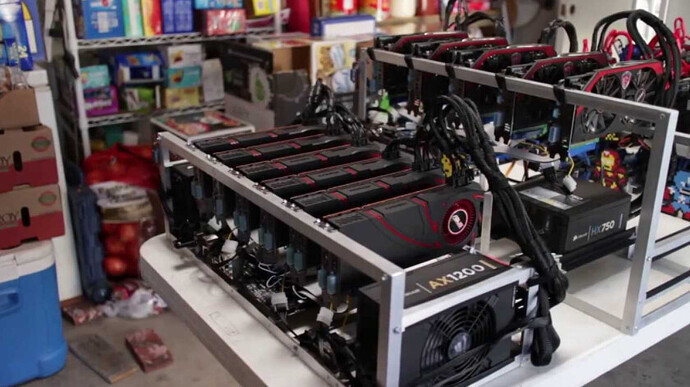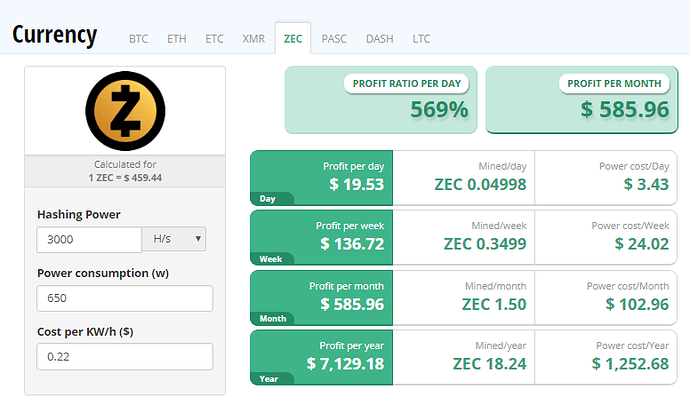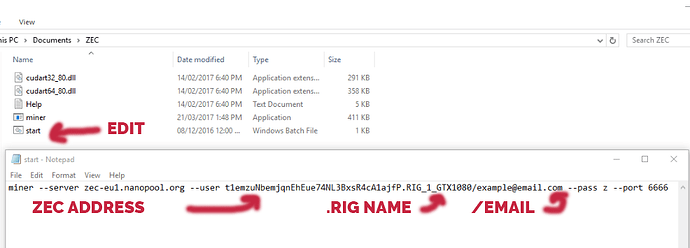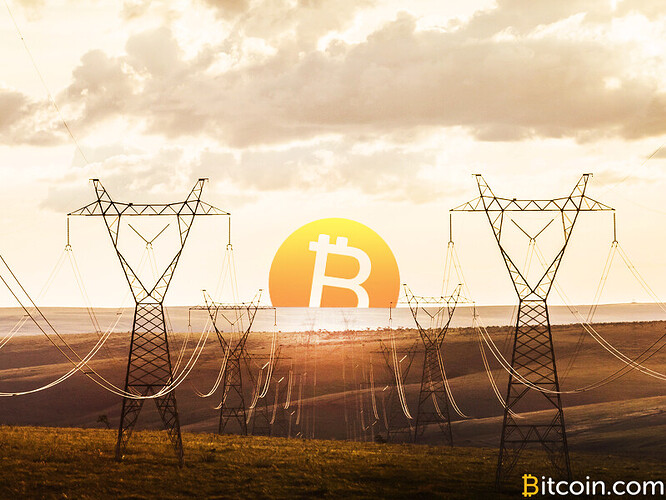Chances are, if you’ve heard of Cryptocurrencies, you have probably come across the term “Mining.” But what actually is it? In layman’s terms, Cryptocurrency miners verify that user’s transactions are real. Every time you transfer a cryptocurrency from one wallet to another you are charged a small fee that goes towards this computing power.
Can anyone mine?
Originally, people were mining on everyday systems such as laptops, USB drives, and even Raspberry PIs! Just like with all technology, advances came quickly and before long people had developed specialist machines that crushed through Bitcoin mining at unbelievable rates.
These devices, known as ASICs, made it unprofitable to continue mining with consumer-grade technology, quickly monopolizing the market and making it practically impossible for hobbyist miners to get started out, due to the high start-up costs associated with ASICs.
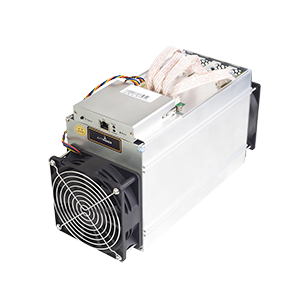
While it is no longer practical (Although still possible) to get into Bitcoin mining, there are thousands of Cryptocurrencies out there that you can mine. Some of these coins are totally unique, many are based on the same hashing algorithms. This is good news for small-time miners, as it means that there are hundreds of coins that can profitably be mined with consumer hardware.
Although it is technically possible to mine on CPU’s, I’m going to be covering GPU Mining. Graphics cards are found inside higher-end computers and are relatively easy to get your hands on. While the Cryptocurrency “craze” has caused prices to rise, they are now dropping in price and are well-stocked.
Even though the Graphics cards do the actual processing, we still need a base computer to run the operating system and mining software from. As our end goal is to make as much money with as little investment as possible, it’s important that we have as many graphics cards as we can get per computer system, or rig.
The issue with this is that, typically, computer motherboards only have 2-3 full sized PCI-E slots (This is the connector that your Graphics cards will plug in to) and they are often too close together to have multiple graphics cards side-by-side. In order to get around this, we are going to use PCI-E Risers (Extenders) that allow the graphics cards to the further away from the motherboard.

Not only does this result in better cooling, as the cards can be spaced appropriately, but it also allows you to utilize the smaller PCI-E slots, that graphics cards don’t normally fit in to. This means that you can fit up to six graphics cards on a normal motherboard. ASRock has actually designed a motherboard specifically for mining, which features 13 PCI-E Slots, and there are rumoured to be companies producing motherboards that can support 10s of cards.

Another issue you can have with large builds is electricity. Each graphics card uses anywhere from 150-250 watts (Varies massively on the specific card) but the most cost-effective power supplies are around the 1000-1500w mark, meaning you may not be able to fit all of them on one power supply. Any easy workaround for this is to use a link-cable, allowing you to use two power supplies on one system.
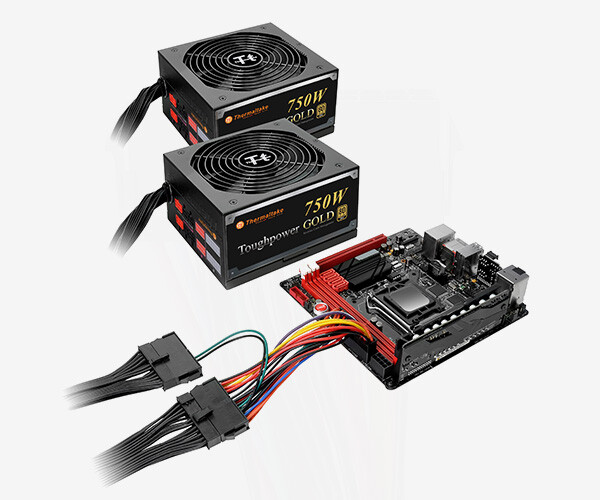
I’m going to go into more detail about all of this later on, but I felt it was important you had a brief understanding of the main components & issues that there are with building a mining system like this.
How Much Can You Earn Mining Cryptocurrencies?
Don’t be fooled. Mining isn’t something that will turn your $10 into millions, it requires a (somewhat) substantial investment. You can, of course, configure your system to meet your budget requirements but for a starter, six card rig, you can expect to pay between £1000 and £4000. Some systems will pay you back quicker, others will earn more in the long-run and others are more future proof. It really is all dependant on your start-up budget & re-investment plan. I’ll be talking more about re-investing later, as well as listing a few different configurations at different price-points.
That being said, you can make a lot of money mining cryptocurrencies. A lot of people will try and tell you that you are too late and have missed the ship, but that couldn’t be further from the truth. I’ve been mining for around six months now, and have already doubled my investment. One thing that people often don’t take into consideration when calculating an ROI is the value of your system. Yes, it is a depreciating asset, but it’s definitely still worth a lot after you’re finished with it (I’ll talk more about when the best time to sell is later on)
Another thing to take into consideration is the possibility of your mined coins increasing in value. Cryptocurrencies can go up and down so much that it can often be hard to decide whether to sell or not. Some people sell every day, others every week, and some people only take their electricity cost out and hold the rest. Holding is where the real money is to be made in mining and, if you do it right, you can more than tripple your normal mining earnings over the course of a year.
The trouble with calculating profit is that there are many variables at play that influence your earnings. There are many Mining Profitability Calculators online that offer an insight into how much you can expect to make. They work by calculating your potential daily/hourly earnings at that exact time and then using that figure to calculate weekly/monthly/yearly earnings.
This is unreliable information because you can’t predict any of the variables that affect this number. So then, what determines how much you earn? Before we go on, it’s important to actually understand this. Every coin has a network difficulty, which affects how many of your chosen coin you will receive for your mining. If the total network power of a coin were to suddenly change then the miners would be earning too much/ not enough of the coin. In order to prevent this, the mining difficulty increases/ decreases to reflect the network power resulting in a somewhat consistent total payout, in the currency.
Naturally, you would assume this means that you can profit massively (or lose a lot of money) if the price of the currency were to suddenly change, however, the difficulty is somewhat proportional to the price, meaning that (while you may experience a few hours/days of strange earnings) there won’t be a massive change once it has settled. This (Very old) thread is a great read.
Electricity Cost: Electricity cost is a massive factor in the mining industry, as GPUs draw a massive amount. If you’re not careful, and have a high electricity cost, it may not be worthwhile.
I use an Electricity Usage Monitor to accurately calculate my costs, however, the maths formula is very simple if you don’t want to buy one. Your electricity cost is KW/h usage * cost per unit * 24. For example, a rig that draws 1000Ws with an electricity cost of $0.18 per unit (Or KW/h) will cost 1240.18 or $4.32/day.
What setups do I recommend?
As mentioned above, there are mining solutions for all budgets. It’s really up to you to decide what GPU you want to go with as well as what brand of that GPU you like the most, however, I have put together three general builds for a low, medium, and high budget. Personally, I much prefer Nvidia cards over AMD. CryptoCompare is a fairly good resource for researching individual card’s hash rates, as is VoskCoin’s YouTube channel.
All three of these rigs are going to be six card set-ups, however, you can obviously expand that with the help of the ASRock H110 Pro BTC & a PSU Link cable. One important thing to note, when running a multi-PSU system, is that you should power all of the risers from the same power supply, to regulate the voltage. If you are using the H110 Pro, you should also make sure that your risers don’t short circuit by wrapping them in electrical tape.
Buget :
GPU: 6 x GTX 1060 3GB
Processor: Intel G4400
Motherboard: GIGABYTE GA-Z270P-D3
Ram: Crucial 4GB Ram
Risers: 6x PCI-E Riser
Power Supply: EVGA G2 1300W PSU
Storage: SanDisk 32Gb USB
GPU: 6 x GTX 1070
Processor: Intel Celeron G3900
Motherboard: ASUS STRIX B250F
Ram: Crucial 4GB Ram
Risers: 6x PCI-E Riser
Power Supply: EVGA G2 1300W PSU
SSD: SanDisk SSD PLUS 120GB
GPU: 6 x GTX 1080Ti
Processor: Intel Celeron G3900
Motherboard: ASUS STRIX B250F
Ram: Crucial 4GB Ram
Risers: 6x PCI-E Riser
Power Supplies: EVGA G2 1000 and EVGA G2 750 (Link cable)
SSD: SanDisk SSD PLUS 120GB
Building the frame:
Now that you’ve selected your parts and are ready to go, it’s time to think about how you are going to build the actual system. While a normal computer case is fine if you are mining with 1-2 cards, a normal rig simply cannot fit inside one. There are thousands of frame designs out there (Even some pre-made ones that you can buy) however, the design is so simple it’s so much cheaper to just build it yourself.
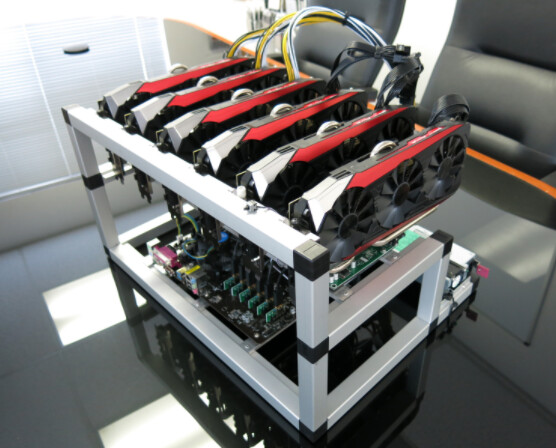
I like to follow a design similar to the one above, using wood instead of metal. All the materials (Wood & screws) are easy to source and after looking at a few designs and watching some YouTube videos, you should be able to put the frame together in under an hour. The rest of the system is just like a regular computer, however, I recommend watching “How to Easily Build a 6x 1080 TI Mining Rig” if you’re unsure.
Setting up Windows:
Linux & Windows are both good for mining, however, I prefer to stick to Windows. It’s easy to set-up but there are a number of things that you need to do in order to optimize for mining:
Removing Your Account Password - Your Computer may restart after an update or if it crashes, so it’s important that it can boot right into windows and begin mining without having to enter your account password. TechAdvisor’s guide is perfect for this.
Install MSI Afterburner - By default, your GPU’s fans are set up to favour being quite over maximum cooling. When you’re maxing out your cards 24/7, it’s important to keep them below 70°C at all times (30-50 is ideal) if you plan on doing this long-term. MSI Afterburner allows you to change the fan speeds on your system, as well as overclock your cards (I don’t do this, but many people say it is worthwhile. Install it, then click the “Auto” button next to fan speed, so that it is dark grey. Now move the speed up to 95-100% and make sure this setting is set on all the cards by going to Settings > “Synchronize settings for similar graphics processors” and of course “Start with Windows.” Save the profile and you’re good to go.
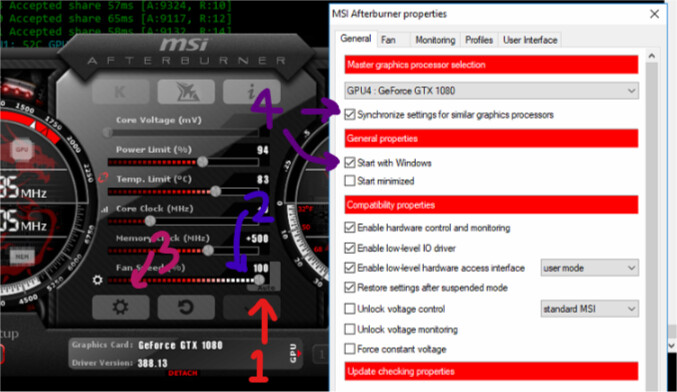
Installing Teamviewer - It’s essential that you can remotely access your system, which is where TeamViewer comes in to play. Download & Install it and make sure to create an account so that the password is static.
While it may seem like a lot of work, it’s important to remember that from here on out your job is to make sure everything’s running fine. Sure, this can get difficult when you have a massive mining operation, but for just a few rigs it’s a few hours of work a month, max. If you are setting up multiple miners, then this tutorial on Cloning your Windows drive is a great watch!
How to ACTUALLY do the mining:
Now that you’ve got the system set-up and working, it’s time to install the mining software. There are two main routes that you can go down for this:
Configurable Mining Script
Managed Mining Software - For example NiceHash
There are a number of good, managed mining clients that automatically switch between the most profitable mining algorithms at any given time. They are incredibly easy to set-up and only require you to press start and begin mining. One of the biggest downsides is that they often pay-out in Bitcoin, regardless of what coin you have been mining. Because of the high Bitcoin transaction fees, this often means that you are only paid out once a week/ fortnight and will miss out on any price increases the coins you actually mined experienced. This also leads to another problem, which we saw happen last week, where your mining funds can be compromised if the company’s security is sub-par.
The second option, which is by-far the best, is downloading coin-specific mining software and setting it up yourself. It only takes a few minutes to configure and gives you loads of flexibility and security. I have a number of scripts downloaded on a USB drive that I can simply double-click to launch when I want to mine a different coin.
Let me run you through a quick example. Currently, I’m mining ZEC with one of my rigs.
Let’s head over to NanoPool (You can pick any ZEC Pool out there) and download the miner that works best with your hardware (Do a bit of testing). Extract the .zip into a folder and then edit the start.bat file. (Right-Click > Edit)
Replace the Zcash address with yours (Get one here) as well as entering a name for your rig, if you want, and then adding your email. The rig name and email aren’t needed to get up-and-running but naming your system makes it easier to track performance when you have multiple systems & the email allows you to be notified when one system disconnects.
Save the file, and you’re done! you can now begin mining by clicking on start.bat! It’s that simple. If you would like to begin mining when Windows turns on, which is highly advisable, then you can add the start.bat file to your start-up files. (This guide explains it well) Simply create a shortcut to start.bat (Right Click > Create Shortcut) then press the Windows Key + R, type shell:startup and move the shortcut into the folder.
You can then go to zec.nanopool.org/account/Your_Address to view your mining stats. For example, https://zec.nanopool.org/account/t1X…W5T2SgfSsiKs3S
Issues with scaling:
While it may seem that Cryptocurrency mining will pay for itself it a matter of months & you’ll be rich in no time, it’s not so simple. One of the biggest issues with scaling your mining operation is electricity usage. As I mentioned earlier, mining systems use a lot of electricity. While this isn’t a massive issue when it comes to profits, as you are still well in the green, issues start to arise when you look at building out a mining “farm.”
Here in the UK, houses typically have a maximum electricity draw of 60-100 Amps, which is split across a number of different circuits. (For example 30Amps for the first floor) Meaning you can have 2-4 rigs in one part of your house. Any more than that and you will likely be over the safe limit. Unfortunately, there’s not much you can do besides renting a warehouse/ office with a better electricity system, which is really only possible if you plan to have ~20+ rigs.
Reinvestment Strategy:
Earlier on, I mentioned how it’s important to include the value of your Rig in your profit calculations. As I’m sure you are aware technology gets better and better over time. As more and more people start mining and newer technology comes out, you will be earning less and less and your system will be worth less with every new hardware product that is launched.
That’s why it’s not necessarily a good idea to reinvest all of your money back into mining as you make it. If you are buying a new rig every month (Imagining that electricity scaling is not an issue for you) then you’re suddenly going to come to a point where you have a massive drop in earnings and an even bigger drop in asset value. In order to minimize the impact of new tech, I have decided to sell my rigs every six months (This is the sweet-spot before your earnings drop too much and your rig is still worth the money you paid for it) and then reinvest that money & some of my mining profits back in to more efficient graphics cards.
For example, just this week I sold my six-month-old mining rig for £3000. The exact amount of money it cost me to build & I plan to replace it with a more efficient rig now that I know what I’m doing.
Personally, I have been more successful with trading cryptocurrencies than mining, which is why I chose to invest most of my earnings into that. While mining is a great investment & is almost completely passive, Cryptos are blowing up right now and there is just so much money to be made with trading. For example, I invested the same amount of money in BTC as I did in my Rigs, and that has quintupled in the same timeframe that my mining investment has doubled. Sure, this is not as secure as mining but I’m already at my house’s electricity limit & it’ll be a good few months before I consider expanding.
